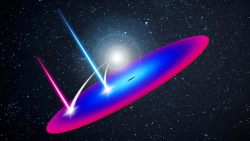Find out the latest thinking about our universe.
-
bystander
- Apathetic Retiree
- Posts: 21576
- Joined: Mon Aug 28, 2006 2:06 pm
- Location: Oklahoma
Post
by bystander » Mon Nov 22, 2021 5:45 pm
 HEAPOW: Reverberating Through History (2021 Nov 22)
HEAPOW: Reverberating Through History (2021 Nov 22)
There's a strange uncertainty in our understanding of quickly the Universe has been expanding since the
Big Bang. The expansion rate of the Universe can be determined by careful study of the so-called
microwave background radiation, the relic radiation left behind after the Big Bang. Another method uses so-called "
standard candles", usually
exploding white dwarf supernovae, to relate the recessional velocities of distant galaxies to their distance from us. Both methods are based on well-understood physical principals, and both give ages of about 13 billion years. But the age determined from studies of the microwave background is about a billion years older than that determined by the supernova studies. Perhaps we don't have a full understanding of all relevant physics in one or both of these techniques? Scientists have now proposed a brand-new method which might help resolve this discrepancy. This new method, called "
reverberation mapping" compares variations in X-ray emission from accreting supermassive black holes to the variations of X-rays reflected from the spinning disk of matter spiraling into the black hole. X-rays are produced in a region of hot gas, the "corona", above and below the accretion disk. Some of these X-rays hit the disk and are reflected from it. When the X-rays from the corona vary, the X-rays reflected from the inner and outer parts of the accretion disk vary too, but with a time delay. The image above shows a schematic of this process. The hot corona is represented as a bright source of light above the colorful accretion disk, where blue represents hotter material close to the black hole, and red lower temperature material in the outer part of the disk. X-rays from the corona are reflected from the inner and outer regions of the disk. By studying X-ray variations from the corona and measuring the time-delayed emission reflected off different parts of the accretion disk using observatories like
NuSTAR and
XMM-Newton and others, researchers can determine the absolute brightness of the disk. This absolute brightness then can be used to
determine a precise distance to the supermassive black hole, and an independent way to determine the expansion of the Universe.
Know the quiet place within your heart and touch the rainbow of possibility; be
alive to the gentle breeze of communication, and please stop being such a jerk. — Garrison Keillor
-
bystander
- Apathetic Retiree
- Posts: 21576
- Joined: Mon Aug 28, 2006 2:06 pm
- Location: Oklahoma
Post
by bystander » Mon Nov 22, 2021 6:00 pm
Black holes can tell us the expansion rate of the Universe
NASA | Caltech | NuSTAR | 2021 Nov 10
Astronomers have discovered a new way to determine the current expansion rate of the Universe, known as the Hubble constant. A paper recently ... describes a method to use X-ray observations of supermassive black holes at the centre of distant galaxies that are gobbling up huge amounts of gas, known as active galactic nuclei. This could settle an on-going dispute between the two existing methods, which disagree on the age of the Universe by more than a billion years.
The Universe began with the Big Bang and has been expanding ever since, but not at a constant rate. The Hubble constant is today's expansion rate. Since every point in the Universe is moving away from every other point, more distant galaxies move away from each other more rapidly. ... The problem is that the supernovae indicate that the Universe is expanding faster than the modelling of the afterglow radiation does. The expansion can be extrapolated backwards in time to work out when the Universe began. The supernovae imply that this was less than 13 billion years ago, whereas the Big Bang afterglow modelling implies it was nearly 14 billion years ago!
Something has to give. It could simply be that the supernovae actually shine a little brighter than is currently thought, and only appear to be so faint because they are more distant. Or it could be that the standard cosmological model for the Universe is missing an important piece of physics. New methods of measuring the Hubble constant are vital to decide between these two eventualities. ...
On measuring the Hubble constant with X-ray reverberation mapping of active galactic nuclei ~ Adam Ingram
et al
Know the quiet place within your heart and touch the rainbow of possibility; be
alive to the gentle breeze of communication, and please stop being such a jerk. — Garrison Keillor
-
saturno2
- Commander
- Posts: 758
- Joined: Wed Jun 29, 2011 10:05 pm
Post
by saturno2 » Mon Nov 22, 2021 11:33 pm
Very interesting
 HEAPOW: Reverberating Through History (2021 Nov 22)
HEAPOW: Reverberating Through History (2021 Nov 22)
